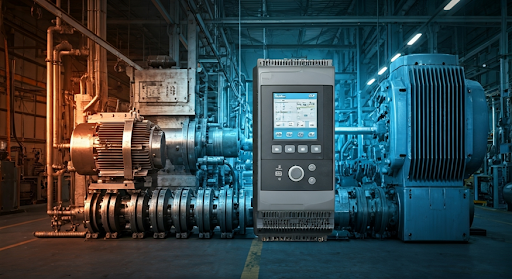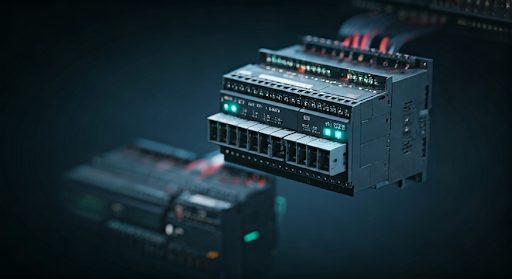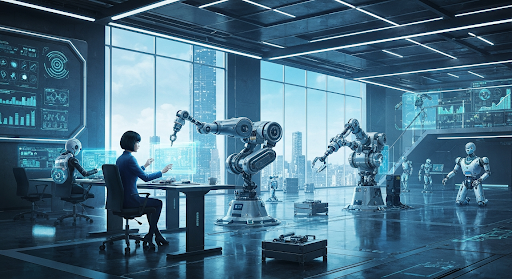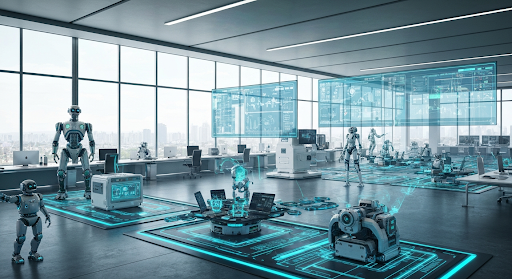How Automation PLC Enhances Industrial Processes Today
Key Highlights
- Programmable logic controllers (PLCs) are foundational to modern industrial automation, efficiently managing process control and machinery.
- PLC programming enables real-time monitoring, data acquisition, and seamless integration with various control systems and output devices.
- Advanced PLCs support complex tasks such as motion control, supervisory control, and high-speed data logging for industrial applications.
- PLCs use diverse programming languages and communication protocols to connect with input devices and sensors for precise control.
- Modular architecture and robust design ensure PLC reliability across different temperature ranges and in environments with electrical noise.
Today’s PLCs provide scalable solutions for assembly lines, food processing, and manufacturing, continually improving productivity and flexibility.
Introduction
Industrial automation has undergone transformative changes with the advent of programmable logic controllers (PLCs). These devices are the backbone of modern manufacturing, providing reliable and customizable control for a variety of automation systems. PLCs manage everything from simple process control to intricate tasks involving motion control and data acquisition. Whether you’re overseeing large-scale production or streamlining individual machinery, PLCs have become indispensable, offering efficient, real-time command and adaptability for a wide spectrum of industrial processes.
Understanding PLCs in Industrial Automation

Manufacturing facilities worldwide rely on PLCs to automate repetitive and complex tasks, making industrial automation possible with precision and consistency. The programmable logic controller serves as the central decision-maker in an automation system, interpreting inputs, executing programmed instructions, and controlling outputs throughout industrial applications.
PLCs are designed for resilience and flexibility, adapting easily to changing requirements. But what exactly is a PLC, and how does it operate within industrial automation systems? Let’s explore its core functions and working principles.
What Is a Programmable Logic Controller (PLC)?
A programmable logic controller (PLC) is an industrial digital computer designed for automation of manufacturing processes, including control of machinery and factory assembly lines. It monitors inputs, processes data, and triggers outputs to ensure optimal operation and efficiency in various industrial applications.
How PLCs Work in Automation Systems
PLCs operate by executing a continuous cycle: reading inputs, processing the control program, and updating outputs. The input devices—such as sensors and switches—transmit signals to the PLC, where ladder logic or other programming languages determine the next steps. This programming logic is designed to mimic relay diagrams, making it accessible for technicians transitioning from mechanical systems.
Output devices, including motors, actuators, and lights, respond to the PLC’s instructions, enabling automated control of machinery. The PLC’s scan cycle ensures real-time responsiveness; for every cycle, it checks all inputs, executes the user program, and adjusts outputs accordingly. This guarantees precision even in high-speed assembly lines or complex process control scenarios.
For integration, PLCs communicate with other automation devices and sensors using communication protocols through physical connections (serial, Ethernet, wireless), expanding the system’s capability to handle large-scale manufacturing or distributed environments.
Key Components and Architecture of PLCs

A typical PLC system comprises several essential components, each with a distinct role in process control. The central processing unit (CPU) executes program logic and real-time operations, while input/output modules interface with external devices. The power supply stabilizes voltage and current, ensuring uninterrupted function, and communication interfaces enable data exchange with remote sensors and automation systems.
Understanding these components and the architecture behind them is crucial when selecting a PLC system for your industrial application and optimizing system performance and reliability.
Central Processing Unit (CPU) Functions
The heart of any programmable logic controller (PLC) is its central processing unit (CPU), responsible for executing the control program. It interprets input signals from devices, like sensors and switches, enabling the system to manage complex tasks in real-time. With robust processing capabilities, it interacts directly with various output devices to regulate machinery and processes. Furthermore, communication protocols allow the CPU to exchange data, enhancing interoperability within automated systems. This seamless integration is crucial for precise motion control and process management.
Input/Output Modules Explained
Input/output (I/O) modules form the connection between the PLC and the physical world. Input modules receive signals from devices like pushbuttons, sensors, and switches, converting analog or digital data into a format the PLC can process. Output modules, on the other hand, deliver control signals to actuators, relays, or electric motors, enabling the PLC to influence machinery and processes.
Analog inputs allow the PLC to monitor variables such as temperature, pressure, or speed, while discrete inputs track simple on/off states. Output modules provide the physical connection necessary for the PLC to activate machinery, control assembly lines, or sound alarms.
Communication between PLCs and other automation devices is achieved through integrated protocols and ports, ensuring data flows efficiently between input devices, output modules, and the central processor. This modular structure allows for tailored solutions specific to any industrial application.
Power Supply and Communication Interfaces
A reliable power supply is fundamental for PLC operation, converting AC voltage to appropriate DC levels for the CPU, I/O modules, and other components. Industrial PLCs are engineered to tolerate electrical noise and variable voltage conditions, preventing interruptions in process control even in harsh environments.
Communication interfaces, including serial, Ethernet, and wireless ports, enable PLCs to interact with remote locations and a wide range of sensors or other automation devices. Modern PLCs use robust communication protocols to maintain secure and efficient data exchange, whether controlling equipment on the plant floor or gathering information from distant sensors.
These interfaces make PLCs especially valuable in distributed automation systems and for integrating with SCADA or HMI devices. By supporting multiple communication ports and protocols, PLCs ensure continuous connectivity, enhance process monitoring, and facilitate rapid troubleshooting across complex networks.
Main PLC Functions in Industrial Processes

PLCs are pivotal in automating industrial processes, from controlling machinery on assembly lines to comprehensive monitoring and data acquisition. Their functions include real-time management of electric motors, actuators, and sensors, supporting seamless operations and improved productivity. Automated systems powered by PLCs enable advanced process logging, efficient supervisory control, and data-driven decision-making. When compared to other control systems, PLCs offer unmatched flexibility, reliability, and ease of programming, making them the preferred choice for modern industrial automation projects.
Monitoring and Controlling Machinery
PLCs manage a broad range of control functions to automate machinery and processes. By processing input signals from devices like sensors and switches, a PLC can:
- Start or stop electric motors on assembly lines.
- Adjust speed and direction for conveyor belts.
- Trigger alarms and safety mechanisms for human operators.
- Initiate precise actions such as valve control or product sorting.
Output signals are sent directly to actuators and motors, ensuring seamless and accurate execution of programmed tasks. Human operators can interact with the process using a human machine interface (HMI), adjusting parameters as needed for optimal performance.
Real-world examples include food processing plants, where PLCs regulate mixing, baking, and packaging, or in automotive manufacturing, orchestrating robotic assembly arms. These applications highlight the PLC’s versatility and reliability in both industrial and home automation scenarios.
Data Acquisition and Process Logging
PLCs excel at data acquisition and process logging, gathering complex data from sensors and equipment to support real-time monitoring. Integrated with SCADA systems, PLCs can record process variables—such as temperature, pressure, and flow rates—providing valuable insights for diagnostics and optimization.
This ability to log and analyze data within an automated system enables operators to track performance trends, identify inefficiencies, and make informed decisions. Modern PLCs support high-speed data logging and advanced communication protocols, ensuring secure transfer and storage of critical process information.
By communicating with other automation devices and sensors, PLCs facilitate comprehensive supervisory control while minimizing downtime and improving productivity. This makes them indispensable for industries requiring rigorous process documentation and regulatory compliance.
PLC Programming Fundamentals
Programming is at the core of PLC functionality. Engineers use specialized programming languages and software to develop control programs that guide process logic and operations. Ladder diagrams remain the most common method, but function block diagrams and other programming languages are frequently employed for complex tasks. PLC programming software provides intuitive tools for writing, testing, and deploying programs, allowing rapid adaptation to changing process requirements. Understanding these fundamentals is crucial for anyone looking to harness a PLC’s full capabilities.
Common PLC Programming Languages
PLCs support several programming languages, each designed for specific control requirements. The most popular is ladder logic, which visually resembles electrical relay diagrams and is easy for technicians to learn. Other languages include function block diagrams (FBD), structured text, sequential function charts, and instruction lists.
Here’s a text table summarizing the main types:
| Programming Language | Description | Typical Use Cases |
|---|---|---|
| Ladder Logic | Graphical relay-based; easy for technicians | Basic logic control, discrete systems |
| Function Block Diagram | Visual blocks for operations, timers, comparisons | Complex process control, automation |
| Structured Text | High-level textual code; flexible syntax | Advance math, algorithms |
| Sequential Function Chart | Step-based process flow; visual sequence mapping | Batch processes, multi-step control |
| Instruction List | Low-level instructions; compact, efficient | Limited use in legacy systems |
Each language’s suitability depends on the complexity of the process, available programming device, and user familiarity.
Steps in PLC Program Development
Developing a PLC control program involves several key steps, starting with defining the program logic based on process needs. Engineers use programming software to design ladder diagrams or other logic structures, mapping input device signals to corresponding actions.
Next, the program is uploaded to the PLC using a programming device, where it’s thoroughly tested for accuracy and reliability. Simulation tools in the software allow for troubleshooting and refining logic before deployment, reducing the risk of errors during operation.
Finally, once validated, the control program is launched, and ongoing monitoring ensures it performs as intended. Updating or modifying the code is straightforward—PLCs are designed for quick edits and adaptation, supporting continuous improvement in automated systems.
Comparing PLCs to Other Control Systems
PLCs have largely replaced relay-based logic and distributed control systems (DCS) as the primary automation method in industry. Their main advantage lies in programmable flexibility, real-time monitoring, and resilience against environmental stressors. While DCS and relay systems still serve specific roles, PLCs excel at managing discrete automation tasks and integrating with modern HMI and SCADA platforms. Understanding the distinctions between PLCs and other control systems helps in selecting the optimal automation solution for your process requirements.
Advantages Over Relay-Based Logic and DCS
PLCs offer significant advantages compared to traditional relay-based logic and distributed control systems (DCS):
- Flexibility: Easily reprogrammed for changing process requirements, reducing downtime and wiring complexity.
- Reliability: No moving parts, ruggedized hardware, and robust ladder logic enhance durability and minimize maintenance.
- Scalability: Modular architecture and support for modern automation systems allow expansion as needed.
PLCs serve as the primary automation method in most industries due to their rapid response, integration capabilities, and cost-effective management of complex tasks. As Dick Morely, the father of PLCs, said, “PLCs revolutionized industrial automation by enabling greater adaptability and control.”
Limitations and Considerations
While PLCs are highly versatile, certain limitations must be considered. Exposure to extreme electrical noise or temperature ranges may impact performance, especially in older or improperly shielded installations. Complex tasks may require additional safety PLCs or advanced controllers to ensure compliance and reliability.
Troubleshooting issues often stem from misconfigured communication ports, outdated programming software, or hardware incompatibility. Maintenance requires skilled personnel to diagnose faults, update programs, and manage system upgrades.
Selecting the right PLC means balancing process complexity with environmental challenges. Regular system reviews and proactive upgrades can mitigate most limitations, keeping automation systems efficient and secure.
Selecting the Right PLC for Your Application
Choosing the ideal PLC for your industrial application depends on process needs, control requirements, and integration with existing machinery or human machine interfaces. Assessing the scale of automation, desired output devices, and remote monitoring capabilities will guide your selection. Modern PLCs offer a range of models and brands, each designed for specific operational demands. Understanding these factors ensures you invest in a controller that aligns perfectly with your automation goals.
Factors to Consider Based on Process Needs
Selecting a PLC involves careful evaluation of your process and application requirements. Consider the following critical factors:
- Number and type of input/output devices to be managed.
- Communication protocols needed for integration with sensors, HMIs, or remote locations.
- Scalability for future expansion and adaptation.
- Environmental conditions such as temperature, humidity, and electrical noise.
PLC systems for remote locations require robust communication interfaces and reliable power supplies. For complex process control, advanced models with high-speed data logging and motion control capabilities are essential. Matching the PLC’s features to your output devices and automation logic ensures seamless operation and efficient process management.
Popular PLC Brands and Models in the Market
The PLC market features many reputable brands and models designed for diverse industrial applications. Here’s a detailed text table:
| PLC Brand | Popular Models | Distinguishing Features |
|---|---|---|
| Productivity | Productivity1000/2000/3000 | Scalable, tag-name programming, advanced communication |
| CLICK | CLICK, CLICK PLUS | Compact, easy programming, ideal for small projects |
| Do-more | BRX, H2, T1H Series | REST API, high-speed I/O, powerful instruction set |
| LS Electric | XGB Series | EtherCAT, IEC languages, motion control |
| General Motors | Original Medicon 084 (historic) | First PLC, foundational for modern plcs |
| Bedford Associates | Developed early PLCs | Innovation in automation architecture |
Modern PLCs from these brands provide versatility, reliability, and advanced programming capabilities, ensuring you find the right solution for your automation project.
Conclusion
In summary, understanding how automation through Programmable Logic Controllers (PLCs) can enhance industrial processes is crucial for staying competitive in today's fast-paced manufacturing landscape. PLCs offer reliability, efficiency, and scalability, transforming the way industries monitor and control their operations. By grasping the fundamentals of PLC architecture, programming, and application, businesses can make informed decisions that improve productivity and reduce downtime. As you consider implementing or upgrading your automation systems, leverage the insights shared here to select the right PLC for your needs. For personalized guidance on integrating PLC technology into your industrial processes, don’t hesitate to reach out for a free consultation.
Frequently Asked Questions
What are typical troubleshooting challenges with PLC automation?
Troubleshooting PLC systems often involves diagnosing issues related to electrical noise, faulty communication ports, or misconfigured programming software. Technicians must check input/output signals, verify program logic, and ensure all connections are secure to maintain seamless operation within the PLC system.
Can PLCs be used for home automation as well as industrial processes?
Absolutely. Programmable logic controllers are suitable for both home automation and industrial processes, managing input devices and controlling output functions in remote locations. While industrial PLCs are more robust, smaller models can automate home lighting, HVAC, and security systems efficiently.
What are the latest advancements in PLC technology?
Modern PLC technology includes enhanced human machine interfaces, advanced motion control, and support for a wide range of communication protocols. Today’s PLCs feature compact designs, integrated data logging, and seamless connectivity—enabling smarter, faster, and more flexible automation than ever before.



